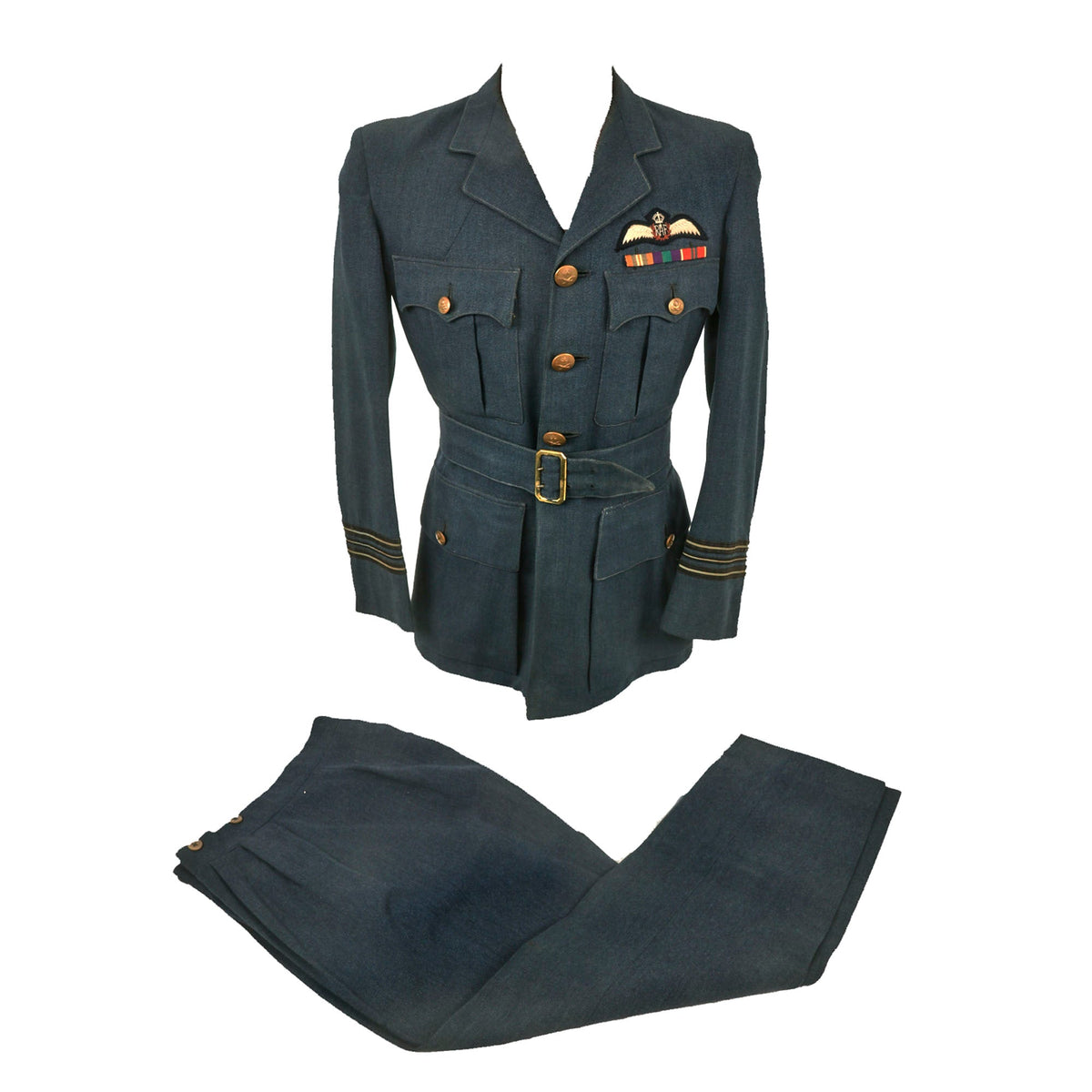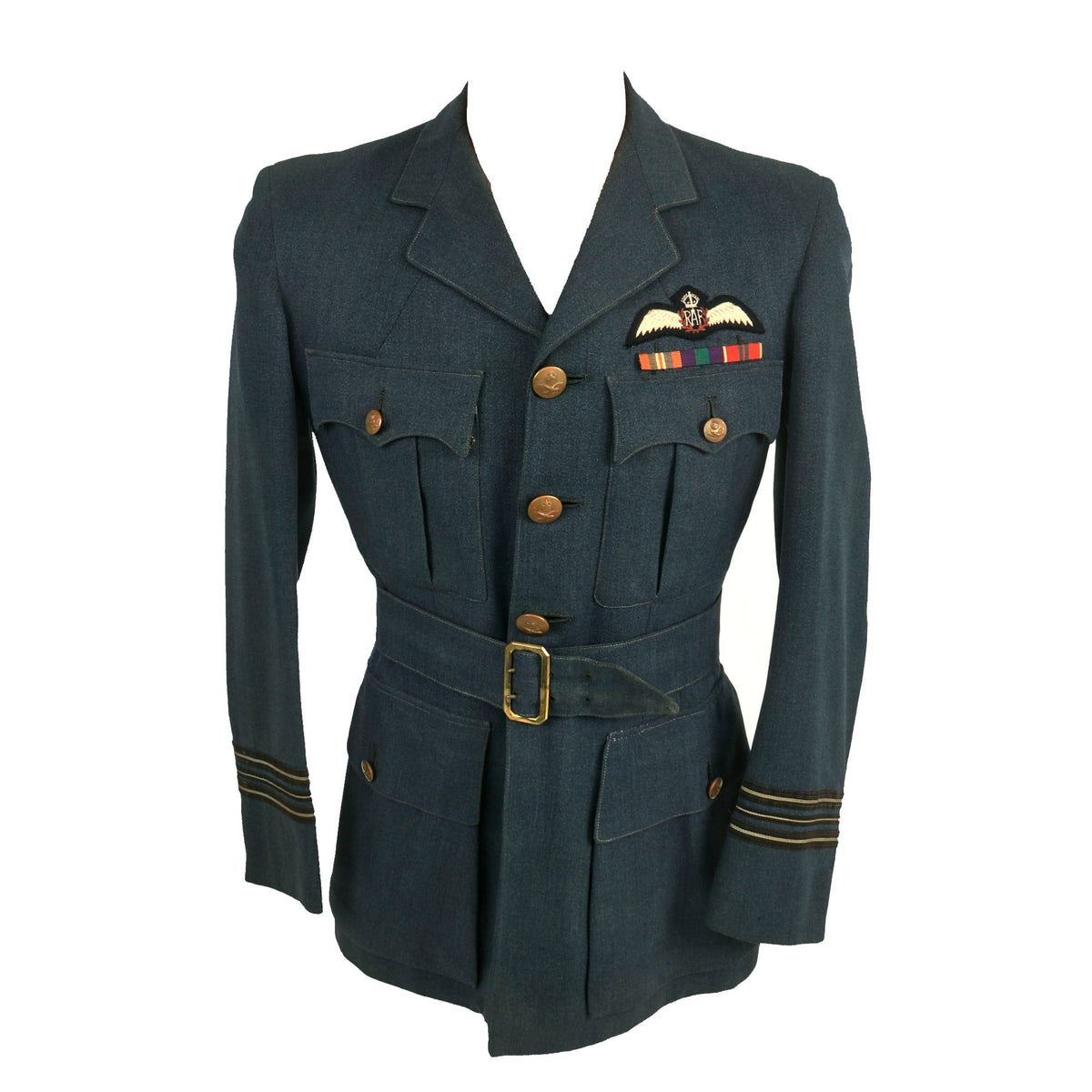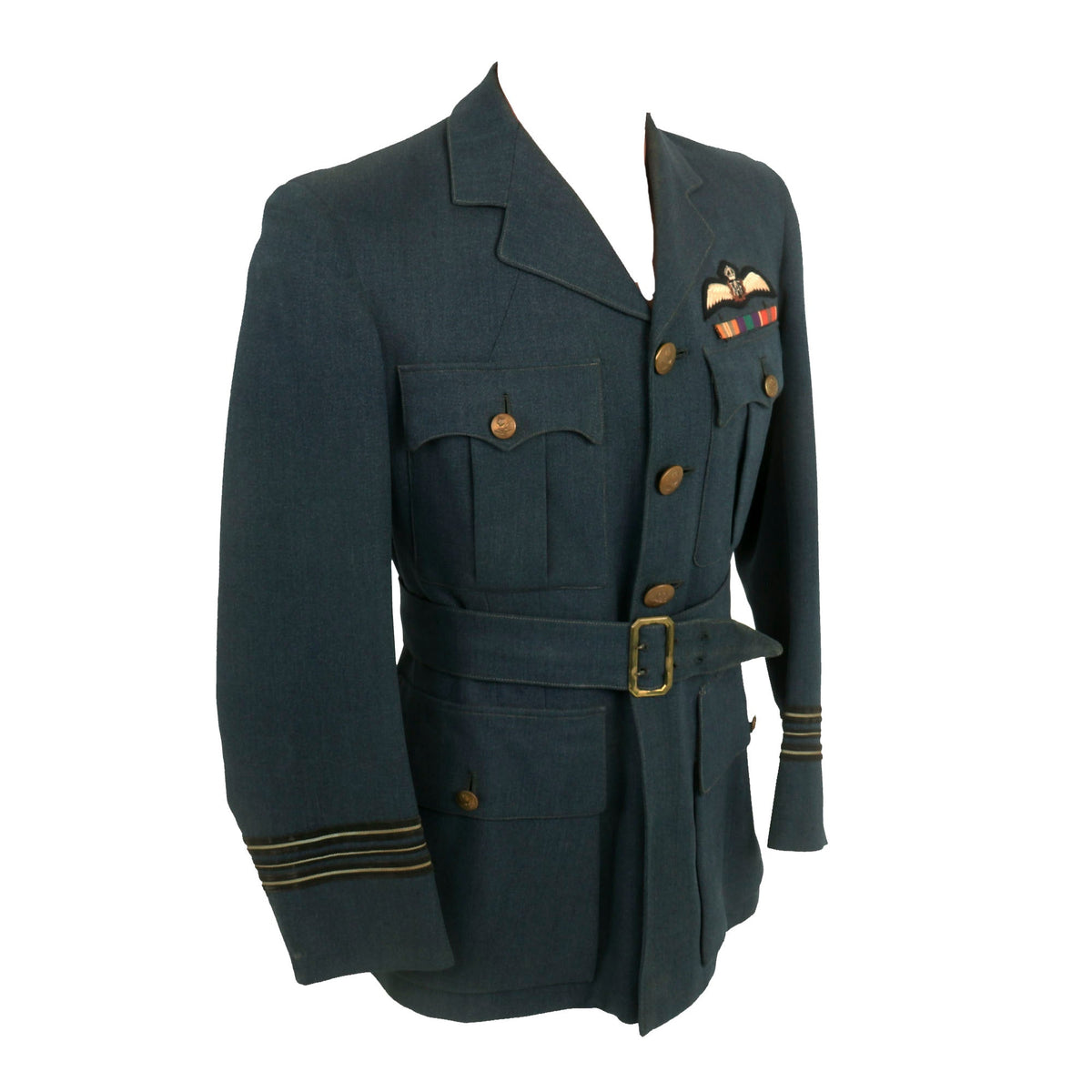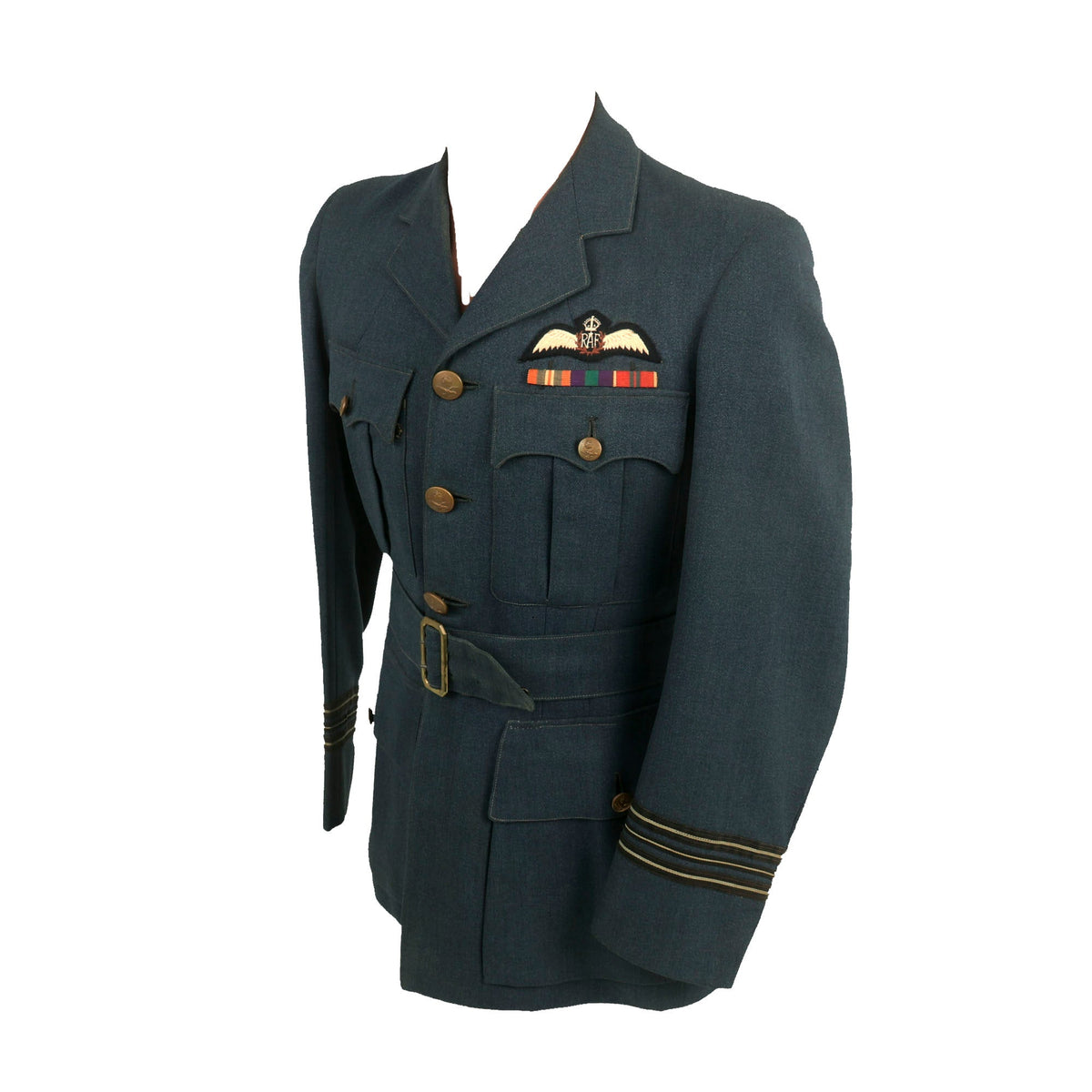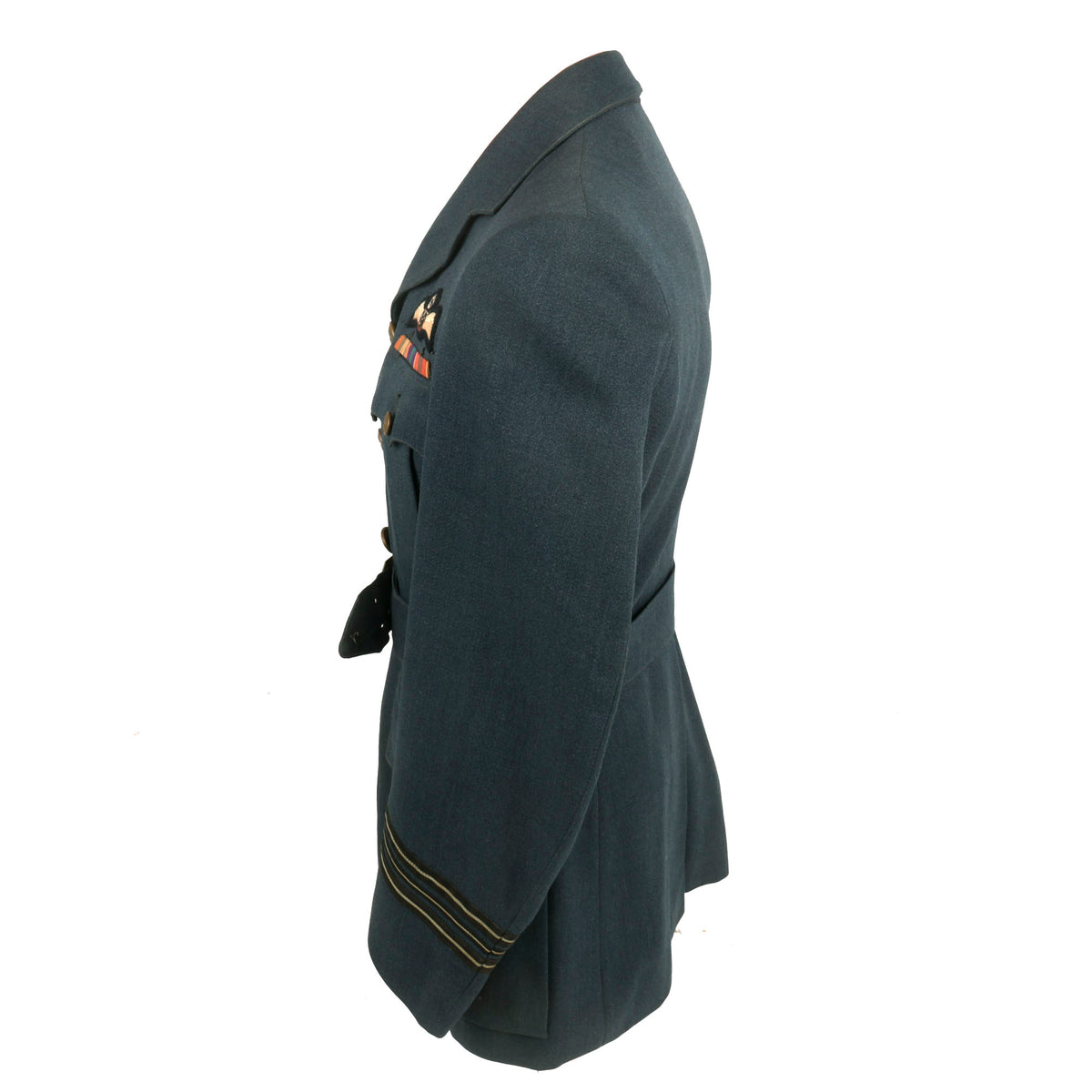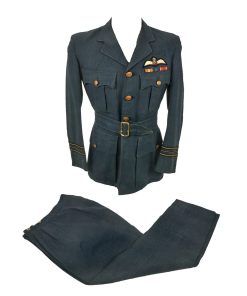Original British WWII Royal Air Force Named Squadron Leader Pilot’s Uniform Jacket & Breeches – RAF Pilot’s Wings and Ribbon Bar Original Items
$ 595,00 $ 178,50
Original Items: One-of-a-kind. This is a Tailor-made Battle Dress Uniform set that belonged to RAF Squadron Leader A. R. Saton. No research has been conducted on this individual, so there’s much potential with this uniform.
Included in this high quality uniform set is are the following:
– Blue wool RAF officer tunic marked to the rank of Squadron Leader. Approximates size US 40 offered in very good condition. Features embroidered RAF wings, and medal ribbons for the 1939 War Medal, the General Service Medal, and the Queen Elizabeth II Coronation Medal. The internal chest pocket bears a tailor label from MOSS BROS & CO LTD of London, W.C. and is ink marked E/LT. A. R. SATON BR27/413. The jacket is in fantastic condition with a few condition issues. The front right breast pocket is missing one of its snaps. The belt still functions very well.
– Blue wool RAF officer’s breeches in impeccable condition with very few flaws.
Overall a very nice hard to find Royal Air Force Squadron leader uniform from the early part of World War Two offered in very good condition.
The RAF underwent rapid expansion prior to and during the Second World War. Under the British Commonwealth Air Training Plan of December 1939, the air forces of British Commonwealth countries trained and formed “Article XV squadrons” for service with RAF formations. Many individual personnel from these countries, and exiles from occupied Europe, also served with RAF squadrons. By the end of the war the Royal Canadian Air Force had contributed more than 30 squadrons to serve in RAF formations, similarly, approximately a quarter of Bomber Command’s personnel were Canadian. Additionally, the Royal Australian Air Force represented around nine percent of all RAF personnel who served in the European and Mediterranean theatres. During the Battle of Britain in 1940, the RAF defended the skies over Britain against the numerically superior German Luftwaffe. In what is perhaps the most prolonged and complicated air campaign in history, the Battle of Britain contributed significantly to the delay and subsequent indefinite postponement of Operation Sea Lion, His plans for an invasion of the UK. In the House of Commons on 20 August, prompted by the ongoing efforts of the RAF, Prime Minister Winston Churchill made a speech to the nation, where he said “Never in the field of human conflict was so much owed by so many to so few”.
The largest RAF effort during the war was the strategic bombing campaign against Germany by Bomber Command. While RAF bombing of Germany began almost immediately upon the outbreak of war at first it was ineffectual; it was only later, particularly under the leadership of Air Chief Marshal Harris, that these attacks became increasingly devastating, from early 1943 onward, as new technology and greater numbers of superior aircraft became available.[19] The RAF adopted night-time area bombing on German cities such as Hamburg and Dresden. Night time area bombing constituted the great bulk of the RAF’s bombing campaign, mainly due to Harris, but it also developed precision bombing techniques for specific operations, such as the “Dambusters” raid by No. 617 Squadron,[20] or the Amiens prison raid known as Operation Jericho.
Fast Shipping with Professional Packaging
Thanks to our longstanding association with UPS FedEx DHL, and other major international carriers, we are able to provide a range of shipping options. Our warehouse staff is expertly trained and will wrap your products according to our exact and precise specifications. Prior to shipping, your goods will be thoroughly examined and securely secured. We ship to thousands clients each day across multiple countries. This shows how we're dedicated to be the largest retailer on the internet. Warehouses and distribution centres can be located throughout Europe as well as the USA.
Note: Orders with more than one item will be assigned a processing date depending on the item.
Before shipping before shipping, we'll conduct a thorough inspection of the items you have ordered. Today, the majority of orders will be delivered within 48 hours. The delivery time will be between 3-7 days.
Returns
The stock is dynamic and we cannot completely manage it because multiple stakeholders are involved, including our factory and warehouse. So the actual stock may alter at any time. It's possible that you may not receive your order once the order has been made.
Our policy is valid for a period of 30 days. If you don't receive the product within 30 days, we are not able to issue a refund or an exchange.
You can only return an item if it is unused and in the same state as the day you received it. You must have the item in its original packaging.
Related products
Uncategorized
Uncategorized
Angolan Rebel 1970s era 60mm Inert Display Mortar from Angolan Civil War Original Items
Uncategorized
Uncategorized
Band of Brothers ORIGINAL GERMAN WWII Le. F.H. 18 10.5cm ARTILLERY PIECE Original Items
Uncategorized
Uncategorized
Uncategorized
Uncategorized
Armored Burgonet Helmet & Polearm from Scottish Castle Leith Hall Circa 1700 Original Items
Uncategorized
Uncategorized
Uncategorized
Uncategorized
Armoured Fighting Vehicles of the World: AFVs of World War One (Hardcover Book) New Made Items
Uncategorized
Uncategorized
Uncategorized
Uncategorized
Australian WWII Owen MK1 Machine Carbine SMG Custom Fabricated Replica with Sling Original Items
Uncategorized
Uncategorized
